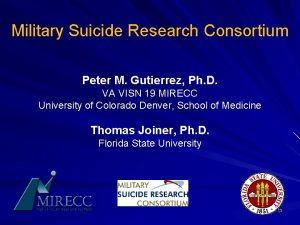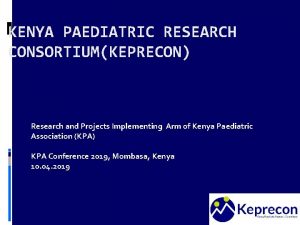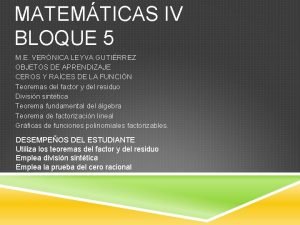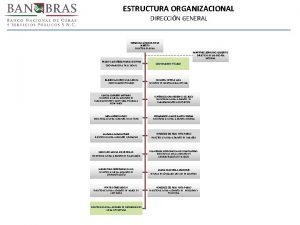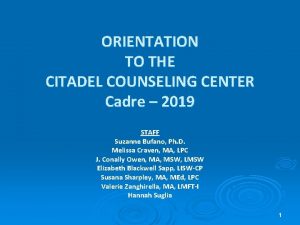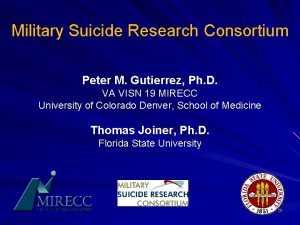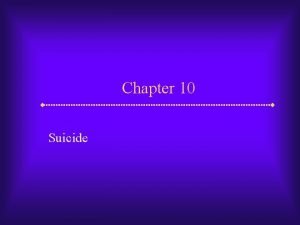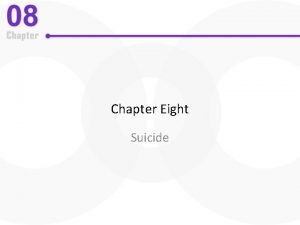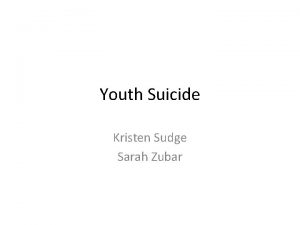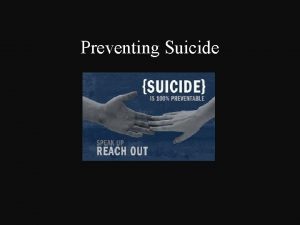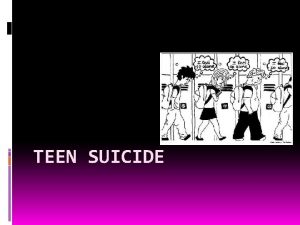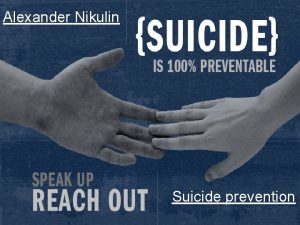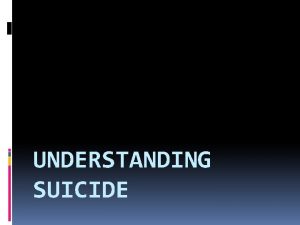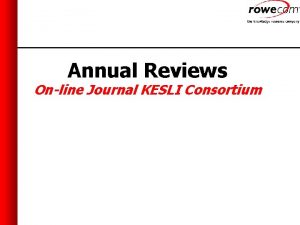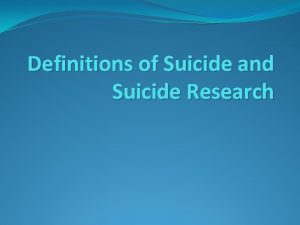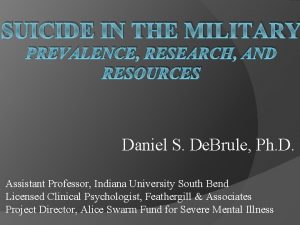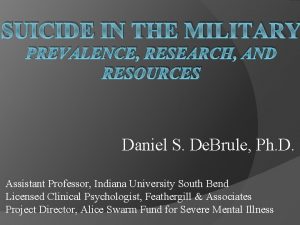Military Suicide Research Consortium Peter M Gutierrez Ph




























- Slides: 28

Military Suicide Research Consortium Peter M. Gutierrez, Ph. D. VA VISN 19 MIRECC University of Colorado Denver, School of Medicine Thomas Joiner, Ph. D. Florida State University

www. msrc. fsu. edu

Co-PIs MIRECC Ø Ø Ø Lisa Brenner, Ph. D. , ABPP Pamela Staves, CNS, NP Perry Renshaw, M. D. Deborah Yurgelun-Todd, Ph. D. M. David Rudd, Ph. D. , ABPP (University of Utah) FSU Ø Greg Riccardi, Ph. D. Ø Jon Maner, Ph. D Ø Chris Schatschneider, Ph. D. Ø Richard Wagner, Ph. D.

Award Date: September 28, 2010 Award Amount: $17 million

Background/Rationale Produce new scientific knowledge about suicidal behavior in the military Use high-quality research methods and analyses to address problems in policy and practice Disseminate knowledge, information, and findings

Organization Chart CORE A Executive Management CORE B INFORMATION MANAGEMENT/ SCIENTIFIC COMMUNICATIO NS CORE C MILITARY/CIVILI AN RESEARCH MONITORING CORE Disseminate to Decision Makers Research Program CORE D DATABASE/STA TISTICAL MANAGEMENT CORE

Core A: Executive Management Core Responsible for ensuring that the mission is accomplished successfully In conjunction with Core B, coordinates public relations activities Develops procedures for publication and data dissemination Oversee disclosure of conflict of interest

Additional Elements of Core A Military External Advisory Board (MEAB) – representatives from all branches, VA and civilian experts – establish initial gaps in the literature on military suicide to be filled by the research program – identifying research program members and outside collaborators Peer Review Program

Core B: Information Management/ Scientific Communications Responsible for disseminating consortium knowledge, information and findings Rapid response to queries Creates and uses controlled vocabularies to ensure accurate searching Technical assistance and support for decision makers Warehouses knowledge about suicidal behavior

Core C: Military/Civilian Research Monitoring Monitors current military and civilian research Works with MEAB for input to address gaps in research Contacts Pis/authors to request information about ongoing research Ensures that all aspects of the Consortium are relevant and sensitive to militaryrelated issues

Core D: Database/Statistical Management Coordinates and assures quality of data collection, data management and data analyses across Consortium Provides support to research projects in the development of tools Monitors the accuracy and confidentiality of all collected data, ensuring data safety is provided Facilitates communication and sharing data, using a Progress Monitoring and Reporting Network (PMRN) Constructs a uniform database structure (UDS) across projects

Research Program Areas Treatment and Case Management Screening and Risk Assessment Basic Research (includes neurobiology and genetics) Prevention Postvention

MSRC Funded Research Caring Texts: – Katherine Comtois, Ph. D, University of Washington Behavioral Sleep Intervention – Rebecca Bernert, Ph. D, Stanford University Virtual Hope Box – Nigel Bush, Ph. D, National Center for Telehealth & Technology (T 2) Reasons for Living – Craig Bryan, Psy. D, University of Utah Anxiety Sensitivity – Norman B. Schmidt, Ph. D, Florida State University

Continuity Contacts Via Text (CCVT) Texting a brief intervention to prevent suicidal ideation and behavior Katherine Anne Comtois, Ph. D MPH Michael Mc. Donell, Ph. D Richard Ries, MD University of Washington Department of Psychiatry

Aims / Hypotheses • Aim 1: Determine if the addition of 12 months of CCVT + TAU results in lower rates of suicidal ideation and behavior relative to TAU alone • 1 a: Reduced suicidal ideation at 12 months • 1 b: Fewer suicide risk incidents (i. e. , those requiring medical evacuation or hospital admission) per participant over 12 months • 1 c: Fewer total # of suicide risk incidents over 12 months • Aim 2: Test two proposed mechanisms of action of CCVT outcome: 1) reduced “thwarted belongingness” and 2) increased engagement in behavioral health services • 2 a: The effect of CCVT compared to TAU will be mediated by reductions in “thwarted belongingness” from pre to post-study • 2 b: The effect of CCVT compared to TAU will be mediated by increased use of OP behavioral health services in CCTV condition

A Behavioral Sleep Intervention for Suicidal Behaviors in Military Veterans: A Randomized Controlled Study Rebecca Bernert, Ph. D. Department of Psychiatry and Behavioral Sciences

A Behavioral Sleep Intervention for Suicidal Behaviors in Military Veterans Primary Aim 1: To develop and test an integrated, manualized behavioral sleep intervention for suicidality, MSPI (Military sleepbased preventive intervention) for suicidal behaviors Primary Aim 2: To examine MSPI effects in lowering suicidal ideation and behavior compared to a control treatment Secondary Aim 3: To examine MSPI effects on improving sleep indices (insomnia, sleep variability, nightmares, poor sleep quality) compared to control Secondary Aim 4: To explore MSPI effects on improving mood and stress measures Secondary Aim 5: To explore if mood or stress indices mediate or moderate MSPI suicidality reductions in treatment

Usability and Utility of a Virtual Hope Box (VHB) for Reducing Suicidal Ideation Nigel Bush, Ph. D. National Center for Telehealth & Technology University of Washington

Virtual Hope Box Phase 1: Prototype development & testing – Translate design specifications into a working prototype – Conduct usability testing 20 active duty service members Joint Base Lewis Mc. Chord (JBLM) – Modify and improve the initial prototype based on feedback

Virtual Hope Box Phase 2: Clinical Proof of Concept Testing – Pilot with no fewer than 10 high-risk-of-selfharm Veterans – VAMC Portland Mental Health Clinic – Data collected semi-structured interviews electronic usage log PHB & VHB Usability Questionnaire Clinical in-person debrief Clinician focus groups Psychological Outcomes

Brief Intervention for Short- Term Suicide Risk Reduction in Military Populations Craig J. Bryan, Psy. D University of Utah

Brief Intervention for Short- Term Suicide Risk Reduction in Military Populations Hypotheses: The crisis response plan with reasons for living (CRP+RFL) intervention will contribute to significantly decreased risk for suicide attempts and hospitalization during follow-up relative to the crisis response plan alone (CRP) and treatment as usual (TAU). The CRP+RFL intervention will contribute to greater ambivalence about suicide and faster recall of reasons for living relative to the CRP and TAU interventions. Greater ambivalence about suicide and faster recall of reasons for living will mediate the relationship between intervention and reduced risk for suicide attempt during follow-up.

Development and Evaluation of a Brief, Suicide Prevention Intervention Reducing Anxiety Sensitivity Norman B. Schmidt, Ph. D. Florida State University

Development and Evaluation of a Brief, Suicide Prevention Intervention Reducing Anxiety Sensitivity Phase I will include the modification of the existing AS reduction protocol and web-based application development. Phase II will include piloting the application on a relevant sample (N=10 -20) to solicit feedback and may result in further modifications to the application. Phase III, if Phases I and II successful, RCT designed to provide evidence of efficacy for the intervention along with platform conversion of the application. Could be funded in period 2.

MSRC Common Data Elements Facilitate secondary analyses of aggregate data across all funded studies 55 items (approx 5/domain) – Anxiety sensitivity, insomnia, wish to live vs. wish to die, burden, belonging, hopefulness, TBI sequelae, PTSD symptoms, substance abuse, suicidal ideation, self-directed violence (suicidal and non-suicidal), suicide intent

MSRC Project Deliverables Development of comprehensive approach to preventing suicide among Military Service members and Veterans ensuring scientific basis exists to support suicide risk screening, assessment, prevention efforts, and interventions Creation of infrastructure for decision-makers and public for reliable information on questions regarding suicide and suicidal behavior in the military and Veterans Expanding knowledge, understanding, and capacity to prevent, treat, and enhance quality of life for those in military communities and the general public affected by suicide and suicidal behavior

Dissemination/Transition Plan Website www. msrc. fsu. edu Journal articles and books Ribeiro, J. D. , Pease, J. L. , Gutierrez, P. M. , Silva, C. , Bernert, R. A. , Rudd, M. D. , & Joiner, T. E. (in press). Sleep problems outperform depression and hopelessness as cross-sectional and longitudinal predictors of suicidal ideation and behavior in young adults in the military. Journal of Affective Disorders. Renewal of consortium after first period

Contact Information Peter M. Gutierrez, Ph. D. VISN 19 MIRECC Denver VAMC peter. gutierrez@va. gov Washington, DC September 13, 2011
 Youth suicide research consortium
Youth suicide research consortium Estrutura de uma carta informal
Estrutura de uma carta informal Kenya paediatric research consortium
Kenya paediatric research consortium Uchicago consortium on school research
Uchicago consortium on school research Rochelle gutierrez creative insubordination
Rochelle gutierrez creative insubordination Felipe santiago gutiérrez
Felipe santiago gutiérrez Servulo gutierrez los andes
Servulo gutierrez los andes Jose ezequiel gutierrez gomez
Jose ezequiel gutierrez gomez Division sintetica
Division sintetica Michael gutierrez sacramento city college
Michael gutierrez sacramento city college Estructura organizacional de juan valdez
Estructura organizacional de juan valdez Fray saturnino gutierrez
Fray saturnino gutierrez Cuberos cortés gutiérrez
Cuberos cortés gutiérrez Penina wants to insert markers
Penina wants to insert markers Erlinda gutierrez
Erlinda gutierrez Miguel gutierrez md
Miguel gutierrez md Ana karen gutierrez edad
Ana karen gutierrez edad Marcela bernal
Marcela bernal Mapa de diego gutierrez 1562
Mapa de diego gutierrez 1562 Melisa gutierrez 7
Melisa gutierrez 7 Hospital fernando quiroz issste
Hospital fernando quiroz issste Ana karen gutierrez
Ana karen gutierrez Ricardo leyva gutiérrez
Ricardo leyva gutiérrez Suicide girls colombia
Suicide girls colombia Mad acronym suicide prevention
Mad acronym suicide prevention Citadel counseling center
Citadel counseling center Bill nye life cycles
Bill nye life cycles Icd 10 luka bakar
Icd 10 luka bakar Glencoe health chapter 5 review answers
Glencoe health chapter 5 review answers
